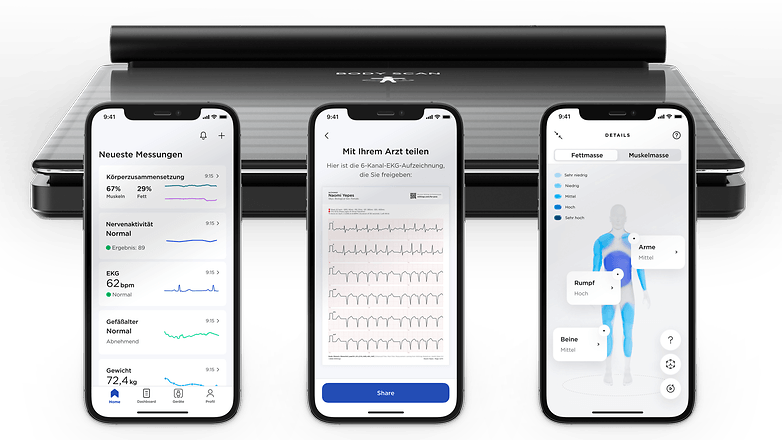In 2009 Withings introduced the first connected body fat scale. A lot has happened since the “Body” – also among the competition. With the Body Scan presented today, Withings wants to be one step ahead again. The focus is on a sensor handle that the user holds in their hands while weighing.
- Withings Body Scan measures the composition of the upper and lower halves of the body thanks to the handle
- Cardiovascular health can be measured as “vascular age” compared to real age
- Diabetics benefit from an early warning system for peripheral neuropathy
- At 299.99 euros MSRP, the scale is anything but a bargain
Like the various previous scales, the Body Scan measures the pulse. However, with the help of the sensors integrated in the handle, the Withings can also perform a 6-lead ECG. This allows – at least theoretically – the detection of cardiac arrhythmias. Smartwatches are somewhat more restricted here with their 1-channel EKGs.
Like its predecessor, Body Cardio (via software update), the Body Scan can also measure blood vessel age. This is done by measuring the pulse wave speed – the scale can therefore measure the speed at which the pressure wave of the heartbeat propagates along the aorta and the arterial vascular tree. A “vascular age” can be determined on the basis of the measured values.
The handle looks funny, but it expands the Withings Body Scan significantly. / © Withings
New to the Body Scan is a warning system for peripheral neuropathy. These are nerve diseases for which diabetes sufferers are at high risk. For early detection, the electrodes in the scales and the sensor handle measure the ability of the sweat glands to release chloride ions in response to stimulation. The principle is not new, but was not previously used in body fat scales.
Speaking of body fat scales: Of course, the Withings Body Scan also offers a bioelectrical impedance analysis to measure body composition. One advantage here is the new handle, which allows a more detailed measurement. The previous Withings scales – like all scales without a sensor handle – only measured the composition of the lower half of the body and then extrapolated it to the entire body. But every human being distributes the fat differently on the body due to genetic factors.
In this context, the measurement of visceral fat is also interesting – at least on paper. This is the unpleasant belly fat between the organs, which usually means an increased risk of cardiovascular diseases. As with the features mentioned so far, the same applies here: It will be exciting to see how well it all works in practice.
The bottom line is that Withings wants to use all these measurements to create personalized health plans that users can use to work on their fitness. If necessary, the manufacturer also wants to establish a connection to medical specialists directly via the app.

The Withings Health-Mate app offers a wide range of options for evaluating the data. / © Withings
What else is there to say? The battery integrated in the scales should last a year and can be recharged via a USB cable. You can marvel at your health data via the Withings Health-Mate app – or directly via the 3.2-inch LCD in the scales. The Body Scan will not yet help you trample away the Christmas bacon: The scale will only appear in the second half of 2022 and cost 299.99 euros.
